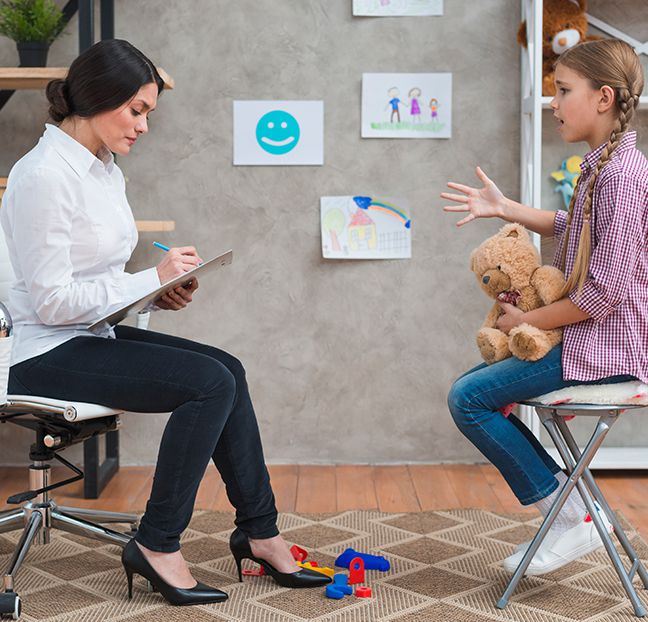
Sensory Integration Therapy Services in Karachi
Book An Appointment For Intake Session / Consultancy / OPD charges Rs. 1000/- only
Connect With Us For The Consultancy
A Path to Balance and Brilliance
Sensory Integration Therapy
Sensory Integration Therapy is a specialized intervention aimed at assisting individuals who struggle with processing sensory information from their surroundings. This therapeutic approach places its emphasis on tackling Sensory Processing Disorder (SPD) and other related sensory challenges, which have a notable impact on everyday functioning and overall quality of life. By engaging individuals in a carefully planned series of sensory-rich activities and exercises, Sensory Integration Therapy aims to improve sensory processing, enhance motor skills, and foster emotional regulation. Skilled occupational therapists and sensory integration specialists lead this evidence-based therapy. It helps patients effectively navigate their sensory environment, leading to improved participation in various activities and a boosted sense of confidence and comfort in their daily lives.
During Sensory Integration Therapy, a skilled occupational therapist works closely with the individual to create a tailored treatment plan based on their specific sensory needs and challenges. The therapy typically involves engaging in various sensory-rich activities and exercises to gradually expose the individual to different sensory stimuli. These activities are crafted to push and retrain the brain's sensory processing abilities, ultimately resulting in more efficient responses as time goes on.
The main objective of Sensory Integration Therapy is to help individuals better organize and interpret sensory input, leading to increased comfort and confidence in their interactions with the surrounding environment. SIT aims to promote adaptive responses and enhance sensory processing abilities, motor skills, emotional regulation, and social interactions by providing a structured and supportive setting that gradually exposes individuals to sensory challenges.

Inspire for Better Living…
Let’s Connect!

Sensory Integration Therapy is guided by several fundamental principles:
- Individualized Approach: Each individual's sensory processing challenges are unique, necessitating personalized therapy plans tailored to their specific needs and strengths.
- Play-Based Activities: SIT incorporates playful and engaging activities to create a comfortable and enjoyable environment, especially for children, encouraging exploration, learning, and development.
- Gradual Exposure: Therapy sessions progressively introduce sensory challenges, allowing individuals to build tolerance and develop coping strategies at their own pace.
- Adaptive Responses: Experienced therapists closely observe an individual's responses to sensory input and adjust therapy techniques to encourage positive adaptive behaviors.
- Environmental Modification: Therapists may recommend adjustments to an individual's surroundings to reduce sensory triggers and facilitate better integration.
Benefits of Sensory Integration Therapy:
Sensory Integration Therapy offers numerous advantages to individuals with sensory processing challenges:
- Enhanced Sensory Processing: SIT helps individuals better organize and interpret sensory information, reducing sensory overload and improving focus and attention.
- Improved Motor Skills: Individuals can develop better motor coordination and balance by engaging in various physical activities.
- Increased Self-Confidence: Achieving success in therapy boosts an individual's confidence, leading to improved self-esteem.
- Improved Emotional Control: SIT helps individuals effectively handle their emotional reactions, lowering anxiety and stress related to sensory difficulties.
- Enhanced Social Interaction: Addressing sensory difficulties can result in improved social skills and a deeper sense of connection with others.
- Better Academic Performance: Improved sensory processing and attention can positively impact academic performance, as individuals can focus better on learning tasks.
- Greater Participation in Daily Activities: Sensory integration therapy enables individuals to engage more completely in a wide range of activities in their everyday lives, including those at home, school, work, and within their community.

Sensory Integration Therapy Services in Karachi
Book An Appointment For Intake Session / Consultancy / OPD charges Rs. 1000/- only
Connect With Us For The Consultancy
Overall Sensory Issues
- Visual Processing Issues: Visual processing issues are related to difficulties in processing visual information. this may impact visual perception, tracking, visual-motor integration, and visual attention.
- Auditory Processing Difficulties: Auditory processing difficulties refer to challenges in processing and making sense of auditory information. Individuals with auditory processing issues may struggle to understand spoken language, filter out background noise, or follow auditory instructions.
- Sensory Over responsivity: This refers to an extreme sensitivity or aversion to sensory stimuli. Individuals who are overresponsive may react strongly or become overwhelmed by everyday sensory inputs such as loud noises, bright lights, certain textures, or strong smells. This can lead to avoidance behaviors and discomfort in certain environments.
- Sensory Under responsivity: Sensory under responsivity is characterized by reduced responsiveness to sensory stimuli. Individuals with this issue may seem unresponsive or oblivious to sensory inputs, and they may have difficulty recognizing or responding to environmental cues.
- Sensory Seeking Behaviors: Individuals with sensory-seeking behaviors constantly seek out intense sensory experiences to fulfill their sensory needs. They may engage in activities like spinning, jumping, or touching objects excessively to obtain sensory input.
- Poor Sensory Discrimination: This refers to difficulties in distinguishing between different sensory inputs. Individuals with poor sensory discrimination may have trouble identifying subtle differences in sensory information, leading to confusion or misinterpretation of sensory stimuli.
- Motor Coordination Issues: Motor coordination issues are related to challenges in coordinating movement and maintaining balance due to disrupted sensory integration. This may result in clumsiness, difficulty with fine motor tasks, or challenges in gross motor activities.
- Poor Body Awareness (Proprioceptive Dysfunction): Poor body awareness, also known as proprioceptive dysfunction, refers to difficulties in sensing the position of body parts about each other and the environment. This can lead to challenges with body awareness and spatial orientation.
- Tactile Defensiveness: Tactile defensiveness is a strong negative reaction to touch or certain textures. Individuals with tactile defensiveness may experience discomfort, irritation, or even distress when touched or exposed to specific tactile sensations.
- Difficulty with Vestibular Processing: Vestibular processing issues are related to challenges in processing movement and balance information from the inner ear. This may result in challenges related to posture, balance, and understanding spatial orientation.
- Emotional Regulation Challenges: Emotional regulation challenges stem from difficulties in managing emotions in response to sensory stimuli. Experiencing sensory stimuli can sometimes evoke emotional reactions, which may manifest as emotional outbursts or a tendency to withdraw.
- Attention and Focus Difficulties: Attention and focus difficulties refer to challenges in sustaining attention and concentration, particularly in sensory-rich or overwhelming environments.
- Adaptive Behavior Challenges: Adaptive behavior challenges result from difficulties in performing age-appropriate activities of daily living due to sensory processing issues. This may include self-care tasks, academic activities, and social interactions.
How TWC Copes Over These Issues
Improving Visual Processing
Utilizing visual aids and organizers, our therapists at TWC support visual processing and understanding. Eye-tracking and visual-tracking exercises enhance visual-motor integration, leading to improved visual perception and learning.
Safe Exploration of Sensory-Seeking Behaviors
Our therapists at TWC encourage the safe exploration of sensory-seeking behaviors through appropriate sensory outlets and engaging sensory-rich play activities. This enables individuals to satisfy their sensory needs in a controlled manner, minimizing potentially disruptive or unsafe behaviors.
Boosting Body Awareness and Confidence
At TWC, proprioceptive activities, like deep pressure exercises and heavy work tasks, help improve body awareness. These activities enable individuals to gain a better sense of their body position and movement in space, boosting body confidence and spatial orientation.
Developing Emotional Regulation Strategies
TWC's therapists teach emotional regulation strategies, such as deep breathing and mindfulness techniques, to manage emotional responses. Creating calming sensory spaces provides individuals with a retreat to self-regulate when feeling overwhelmed.
Supporting Auditory Processing
TWC's therapists use visual cues and gestures to support auditory information processing. Active listening exercises facilitate better communication and understanding for individuals with auditory processing difficulties.
Enhancing Sensory Discrimination
TWC's therapeutic approach includes activities focused on improving sensory discrimination. By engaging in texture-matching games and sound recognition exercises, individuals can better distinguish between different sensory inputs, leading to improved sensory processing and understanding.
Overcoming Tactile Defensiveness
With sensitivity and positive reinforcement, our therapists at TWC gradually introduce textures to desensitize tactile sensitivity. This process fosters greater tolerance and acceptance of different tactile sensations.
Fostering Attention and Focus
TWC incorporates sensory activities that promote alertness and focus, like fidget tools and movement breaks, to enhance attention and time management skills.
Encouraging Awareness and Responsiveness
TWC incorporates sensory-rich activities and exercises to engage individuals with sensory under responsivity. By incorporating stimulating sensory experiences, we aim to increase awareness and responsiveness to sensory stimuli, promoting a more alert and engaged state.
Developing Motor Coordination
Individuals experiencing motor coordination challenges receive specialized support at TWC. Our occupational therapists employ a variety of motor skills development activities, such as balance exercises and fine motor tasks, to enhance coordination and motor planning.
Regulating Vestibular Processing
TWC incorporates vestibular activities, such as swinging, spinning, and rocking, to address vestibular processing challenges. Engaging in these activities supports improved balance and movement regulation.
Supporting Adaptive Behavior
Individuals facing adaptive behavior challenges receive visual support and step-by-step instructions at TWC. Positive reinforcement and rewards foster increased independence and confidence in daily living tasks.
Sensory Integration Therapy Services in Karachi
Book An Appointment For Intake Session / Consultancy / OPD charges Rs. 1000/- only
